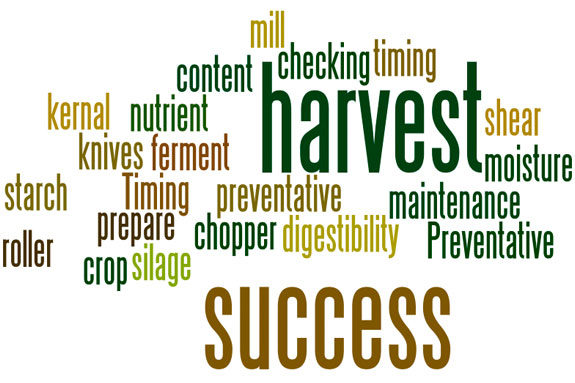Preventative maintenance may seem like a low priority, but being prepared before fieldwork reduces both your downtime and your stress.
Prepare for harvest with pre-harvest preventative maintenance that includes checking condition of the shear bar and chopper knives to assure a precise and accurate chop length is achieved. Examining the condition of the roller mill is advised to assure desired kernel processing can be achieved.
Timing affects quality
Harvest timing directly influences the silage crop’s nutrient value and is the single biggest factor in determining its quality for feeding beef and dairy cattle.
Harvest timing also affects your ability to store the crop so it ferments properly. When crops are harvested at the proper moisture level, you ensure your crop has adequate fermentation, high starch content and retains fiber digestibility.
“Timing is the single biggest factor in determining the quality of the silage for the cows,” Seglar reports. The ideal time to harvest corn silage is when the corn has reached the proper moisture level – a range of 63 to 68 percent or at one-half to two-thirds kernel milkline.
Harvesting within this moisture range provides the ideal corn silage maturity level. Harvesting the crop at the lower end of the recommended moisture range will maximize tonnage yields, starch deposition and still retain fiber digestibility.
Check moisture levels
You used to be able to drive down the road and estimate with fair accuracy a field’s moisture level.
However, improved genetics are bred with improved agronomic traits that provide late-season plant health and keeps the plant visually greener as it nears silage maturity.
These traits collectively known as “staygreen” make observations from your truck a less-reliable determination.
While the ideal way to determine moisture level might be to use the silage harvester to collect samples through the middle of a field, it usually is not an ideal option.
Instead, you should take a random sample of whole plants from beyond the end rows, then put them through a landscape chipper shredder and test dry matter using either a Koster Cooker or a microwave oven.
Don’t forget to evaluate harvested silage samples for degree of processing as well. At least three loads should be appraised every hour.
“Pioneer offers processing cups for collecting corn forage samples,” Seglar states. “Just scoop silage into the 32-ounce cup, spread the silage on the ground and count the whole or half kernels.”
Finding two whole kernels or fewer per sample tells you the chop length is ideal; two to four whole or half kernels is adequate. More than five kernels requires chopper roller mill and feed roll speed adjustments to achieve degree of desired processed kernels (Table 1).
Harvesting for success
As silage harvest season approaches, remember that following just a few tips can make it a successful one.
To recap: First, pre-harvest preventative maintenance of silage chopper condition, especially the knives, shear bar and roller mill are maintenance factors key to reducing downtime and stress.
Second, properly measuring moisture levels with random samples of chopped whole plant samples can be accomplished with a landscape chipper shredder and then drying the sample for dry matter determination.
When your corn samples have reached 63 to 68 percent moisture, it’s time to harvest; timing your harvest right directly influences your crop’s nutrient value.
And third, be sure to monitor degree of kernel processing during harvest. By following these three tips, you can count on another successful silage harvest this fall. FG
—Contributed by DuPont Pioneer










